A Quad-Core Dual-Mode Colpitts Voltage-Controlled Oscillator with Octave Tuning Range and Low Phase Noise
Abstract
:1. Introduction
2. Proposed VCO Architecture
2.1. Frequency Tuning Series Resonator
2.2. Quad-Core Dual-Mode Switching
3. Design and Implementation
4. Simulation Results and Comparison
5. Conclusions
Author Contributions
Funding
Data Availability Statement
Conflicts of Interest
References
- Kang, Z.; Yu, C.; Wu, L. 19.3 An 8.9-to-21.9 GHz Single-Core Oscillator with Reconfigurable Class-F−1 and Enhanced-Colpitts Dual-Mode Operation Achieving 209dBc/Hz FoMT. In Proceedings of the 2024 IEEE International Solid-State Circuits Conference (ISSCC), San Francisco, CA, USA, 18–22 February 2024; pp. 1–3. [Google Scholar]
- Kurtoglu, A.; Shirazi, A.H.M.; Mirabbasi, S.; Lavasani, H.M. An Ultra-Low-Power 65 nm Single-Tank 24.5-to-29.1 GHz Gm-Enhanced CMOS LC VCO Achieving 195.2 dBc/Hz FoM at 1 MHz. Electronics 2024, 13, 1162. [Google Scholar] [CrossRef]
- Yousef, K.; Alzahmi, A. A High FoM and Low Phase Noise Edge-Injection-Based Ring Oscillator in 350 nm CMOS for Sub-GHz ADPLL Applications. Electronics 2023, 12, 3769. [Google Scholar] [CrossRef]
- Gagliardi, F.; Manfredini, G.; Ria, A.; Piotto, M.; Bruschi, P. Low-Phase-Noise CMOS Relaxation Oscillators for On-Chip Timing of IoT Sensing Platforms. Electronics 2022, 11, 1794. [Google Scholar] [CrossRef]
- Shu, Y.; Qian, H.J.; Luo, X. 17.4 A 18.6-to-40.1 GHz 201.7 dBc/Hz FoMT Multi-Core Oscillator Using E-M Mixed-Coupling Resonance Boosting. In Proceedings of the 2020 IEEE International Solid- State Circuits Conference—(ISSCC), San Francisco, CA, USA, 16–20 February 2020; pp. 272–274. [Google Scholar]
- Ge, H.; Jia, H.; Deng, W.; Ma, R.; Wang, Z.; Chi, B. 19.5 A 13.7-to-41.5 GHz 214.1 dBc/Hz FoMT Quad-Core Quad-Mode VCO Using an Oscillation-Mode-Splitting Technique. In Proceedings of the 2024 IEEE International Solid-State Circuits Conference (ISSCC), San Francisco, CA, USA, 18–22 February 2024; pp. 356–358. [Google Scholar]
- Li, C.; Guo, J.; Qin, P.; Xue, Q. A Wideband Mode-Switching Quad-Core VCO Using Compact Multi-Mode Magnetically Coupled LC Network. IEEE J. Solid State Circuits 2023, 58, 1959–1972. [Google Scholar] [CrossRef]
- El-Aassar, O.; Rebeiz, G.M. Octave-Tuning Dual-Core Folded VCO Leveraging a Triple-Mode Switch-Less Tertiary Magnetic Loop. IEEE J. Solid State Circuits 2021, 56, 1475–1486. [Google Scholar] [CrossRef]
- Kim, H.; Kim, S.; Jeon, S. An Octave Tuning Range Quad-Core VCO Using a Compact Quad-Mode Transformer-Based Inductor. In Proceedings of the 2024 IEEE Radio Frequency Integrated Circuits Symposium (RFIC), Washington, DC, USA, 16–18 June 2024; pp. 83–86. [Google Scholar]
- Ge, H.; Jia, H.; Deng, W.; Ma, R.; Chi, B. A 194.9 dBc/Hz FoM and 6.8-to-11.6 GHz Quad-Core Dual-Mode Class-F VCO Featuring Wideband Flicker Noise Suppression. In Proceedings of the 2024 IEEE Custom Integrated Circuits Conference (CICC), Denver, CO, USA, 21–24 April 2024; pp. 1–2. [Google Scholar]
- Padovan, F.; Quadrelli, F.; Bassi, M.; Tiebout, M.; Bevilacqua, A. A quad-core 15GHz BiCMOS VCO with −124d Bc/Hz phase noise at 1MHz offset, −189 dBc/Hz FOM, and robust to multimode concurrent oscillations. In Proceedings of the 2018 IEEE International Solid-State Circuits Conference (ISSCC), San Francisco, CA, USA, 11–15 February 2018; pp. 376–378. [Google Scholar]
- Wu, Q.; Deng, W.; Jia, H.; Liu, H.; Zhang, S.; Wang, Z.; Chi, B. 8.1 An 11.5-to-14.3 GHz 192.8 dBc/Hz FoM at 1MHz Offset Dual-Core Enhanced Class-F VCO with Common-Mode-Noise Self-Cancellation and Isolation Technique. In Proceedings of the 2023 IEEE International Solid- State Circuits Conference (ISSCC), San Francisco, CA, USA, 19–23 February 2023; pp. 7–9. [Google Scholar]
- Tripoli, D.; Maiellaro, G.; Pavone, S.C.; Ragonese, E. Interstacked Transformer Quad-Core VCOs. Electronics 2024, 13, 927. [Google Scholar] [CrossRef]
- Zhang, S.; Deng, W.; Jia, H.; Chi, B. An 11 GHz 8-core Series Resonance CMOS VCO with Scalable Ring-coupling Scheme Achieving Phase Noise of -136.8 dBc/Hz at 1 MHz Offset. In Proceedings of the 2024 IEEE Radio Frequency Integrated Circuits Symposium (RFIC), Washington, DC, USA, 16–18 June 2024; pp. 95–98. [Google Scholar]
- Franceschin, A.; Riccardi, D.; Mazzanti, A. Ultra-Low Phase Noise X-Band BiCMOS VCOs Leveraging the Series Resonance. IEEE J. Solid State Circuits 2022, 57, 3514–3526. [Google Scholar] [CrossRef]
- Pepe, F.; Bevilacqua, A.; Andreani, P. On the Remarkable Performance of the Series-Resonance CMOS Oscillator. IEEE Trans. Circuits Syst. I Regul. Pap. 2018, 65, 531–542. [Google Scholar] [CrossRef]
- Zhang, S.; Deng, W.; Jia, H.; Liu, H.; Sun, S.; Guan, P.; Wang, Z.; Chi, B. A Transformer-Based Series-Resonance CMOS VCO. IEEE J. Solid State Circuits 2025, 60, 529–542. [Google Scholar] [CrossRef]
- Levantino, S.; Samori, C.; Zanchi, A.; Lacaita, A. AM-to-PM conversion in varactor-tuned oscillators. IEEE Trans. Circuits Syst. II Analog. Digit. Signal Process. 2002, 49, 509–513. [Google Scholar] [CrossRef]
- Bonfanti, A.; Levantino, S.; Samori, C.; Lacaita, A. A varactor configuration minimizing the amplitude-to-phase noise conversion in VCOs. IEEE Trans. Circuits Syst. I Regul. Pap. 2006, 53, 481–488. [Google Scholar] [CrossRef]
- Hegazi, E.; Abidi, A. Varactor characteristics, oscillator tuning curves, and am-fm conversion. IEEE J. Solid State Circuits 2003, 38, 1033–1039. [Google Scholar] [CrossRef]
- Kim, J.; Mauludin, M.F.; Azzahra, H.A.; Jhon, H.; Lee, S.; Cho, K. An 18–19.2 GHz Voltage-Controlled Oscillator with a Compact Varactor-Only Capacitor Array. Electronics 2023, 12, 1532. [Google Scholar] [CrossRef]
- Yao, Y.; Li, Z.; Li, Z.; Chen, B.; Wang, X. A 3.7-to-10 GHz Low Phase Noise Wideband LC-VCO Array in 55-nm CMOS Technology. Electronics 2022, 11, 1897. [Google Scholar] [CrossRef]
- Hajimiri, A.; Lee, T. A general theory of phase noise in electrical oscillators. IEEE J. Solid State Circuits 1998, 33, 179–194. [Google Scholar] [CrossRef]
- Ham, D.; Hajimiri, A. Concepts and methods in optimization of integrated LC VCOs. IEEE J. Solid State Circuits 2001, 36, 896–909. [Google Scholar] [CrossRef]
- Zirath, H.; Kozhuharov, R.; Ferndahl, M. Balanced Colpitt oscillator MMICs designed for ultra-low phase noise. IEEE J. Solid State Circuits 2005, 40, 2077–2086. [Google Scholar] [CrossRef]
- Quadrelli, F.; Panazzolo, F.; Tiebout, M.; Padovan, F.; Bassi, M.; Bevilacqua, A. A 18.2-29.3 GHz Colpitts VCOs bank with -119.5 dBc/Hz Phase Noise at 1 MHz Offset for 5G Communications. In Proceedings of the 2019 IEEE Radio Frequency Integrated Circuits Symposium (RFIC), Boston, MA, USA, 2–4 June 2019; pp. 167–170. [Google Scholar]
- Möck, M.; Aksoyak, İ.K.; Ulusoy, A.Ç. A Ka -Band Colpitts–Clapp VCO with 30% Tuning Range and High Output Power. IEEE Technol. Policy Ethic 2023, 33, 439–442. [Google Scholar] [CrossRef]
- Xia, X.; Cheng, X.; Chen, F.; Luo, X.; Deng, X. An Improved Colpitts VCO with Low Phase Noise Using a GaAs BiHEMT Process. IEEE Microw. Wirel. Components Lett. 2020, 30, 70–73. [Google Scholar] [CrossRef]
- Florian, C.; D’Angelo, S.; Resca, D.; Scappaviva, F. A chip set of low phase noise MMIC VCOs at C, X and Ku band in InGaP-GaAs HBT technology for satellite telecommunications. In Proceedings of the 2017 IEEE/MTT-S International Microwave Symposium—IMS 2017, Honololu, HI, USA, 4–9 June 2017; pp. 1148–1151. [Google Scholar]
- Kuylenstierna, D.; Lai, S.; Bao, M.; Zirath, H. Design of Low Phase-Noise Oscillators and Wideband VCOs in InGaP HBT Technology. IEEE Trans. Microw. Theory Tech. 2012, 60, 3420–3430. [Google Scholar] [CrossRef]
- Kashani, M.H.; Molavi, R.; Mirabbasi, S. A 2.3-mW 26.3-GHz Gm -Boosted Differential Colpitts VCO With 20% Tuning Range in 65-nm CMOS. IEEE Trans. Microw. Theory Tech. 2019, 67, 1556–1565. [Google Scholar] [CrossRef]
- Lim, C.-W.; Yun, T.-Y. Gm- and Swing-Enhanced Colpitts VCO by Optimization of Capacitance Ratio. IEEE Microw. Wirel. Compon. Lett. 2020, 20, 977–980. [Google Scholar] [CrossRef]
- Leeson, D. A simple model of feedback oscillator noise spectrum. Proc. IEEE 1966, 54, 329–330. [Google Scholar] [CrossRef]
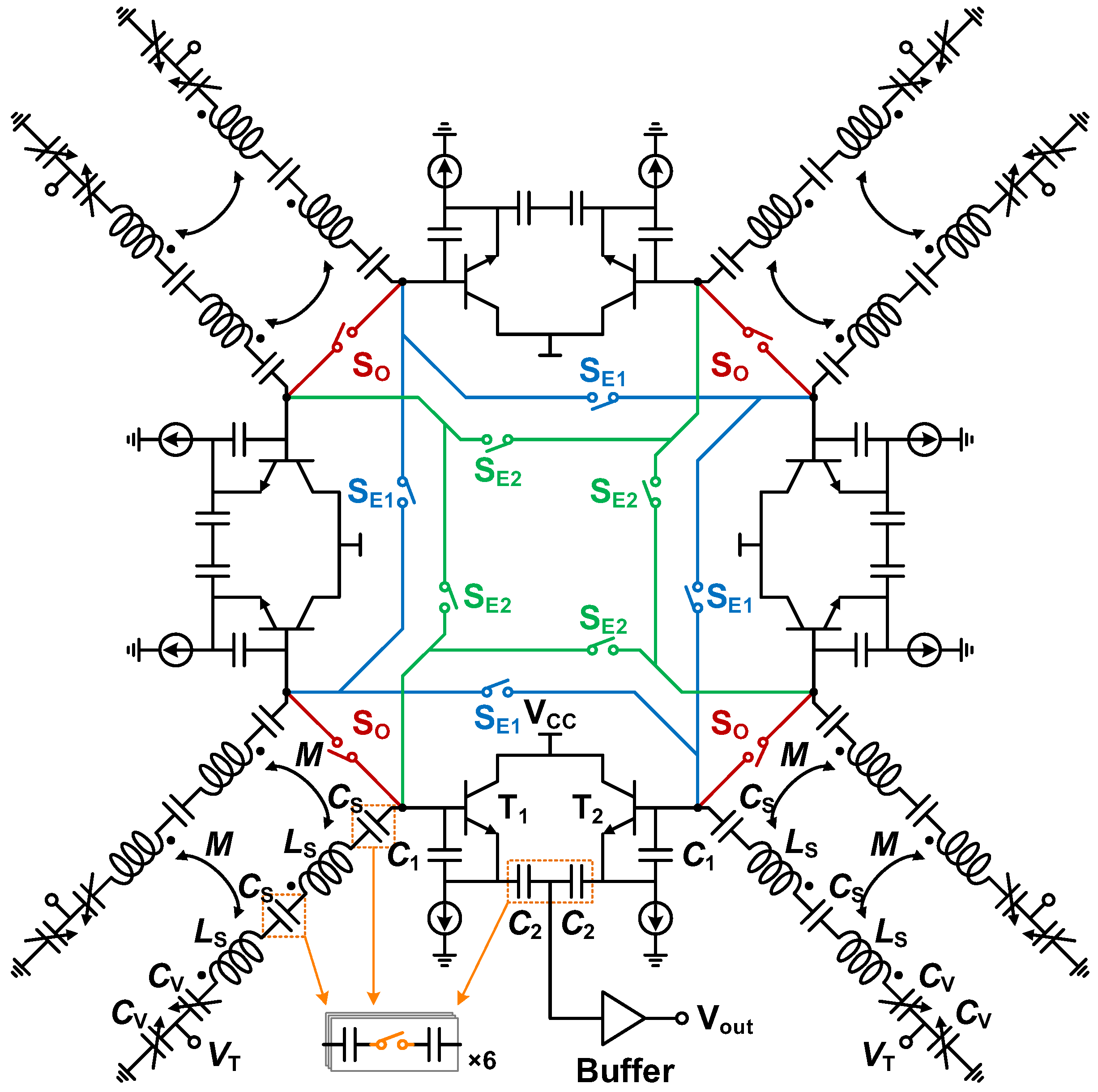
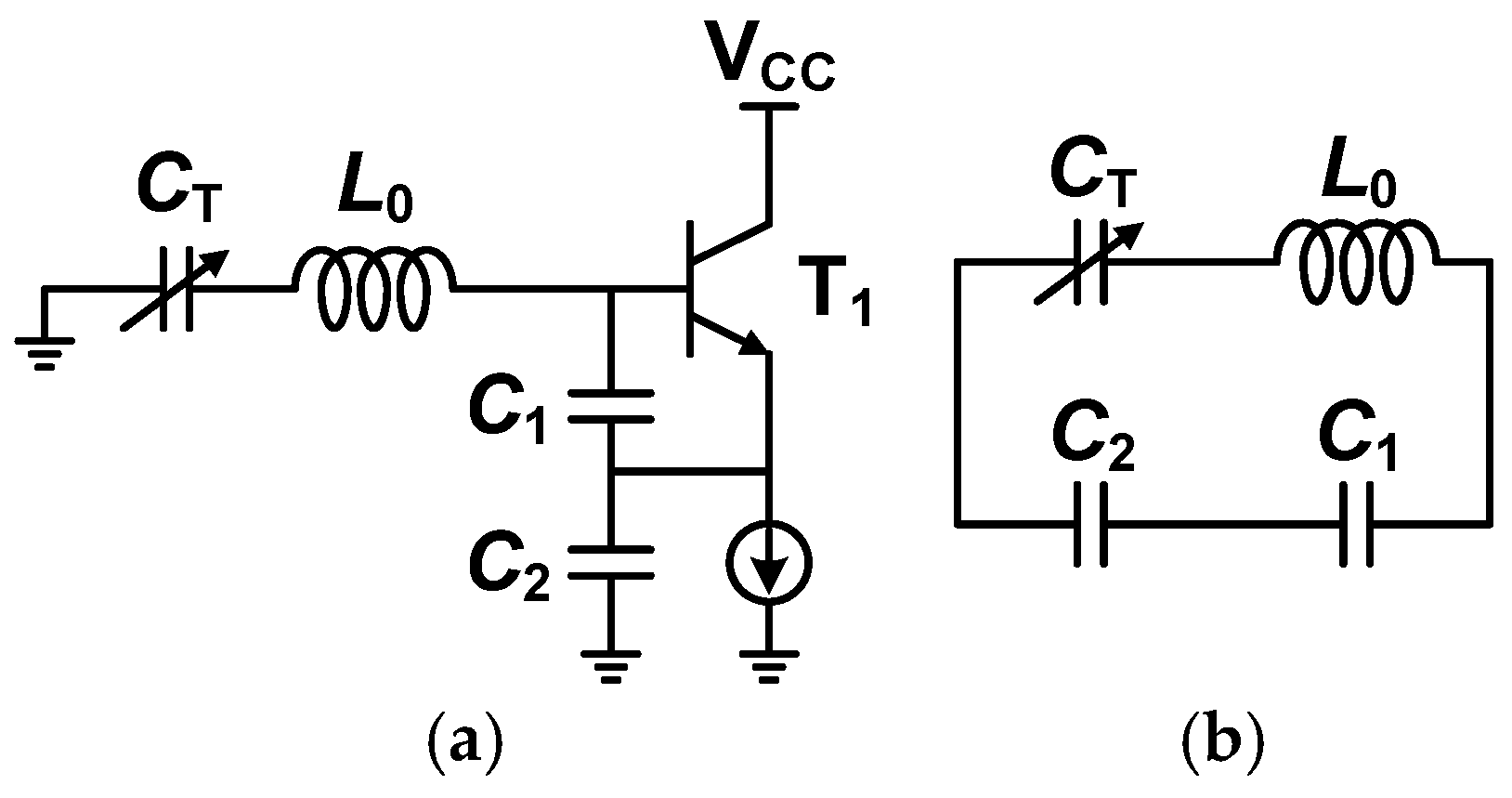
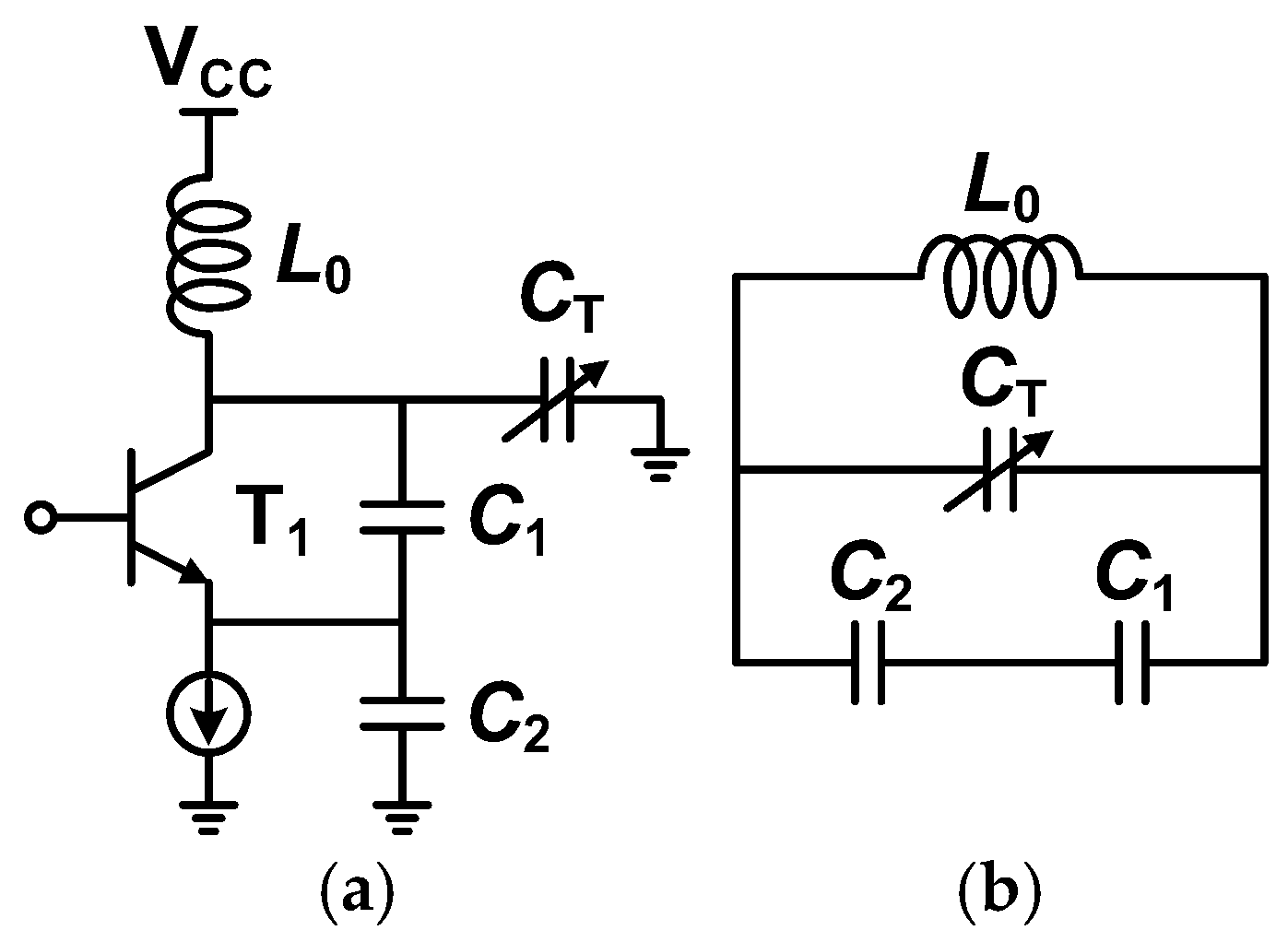
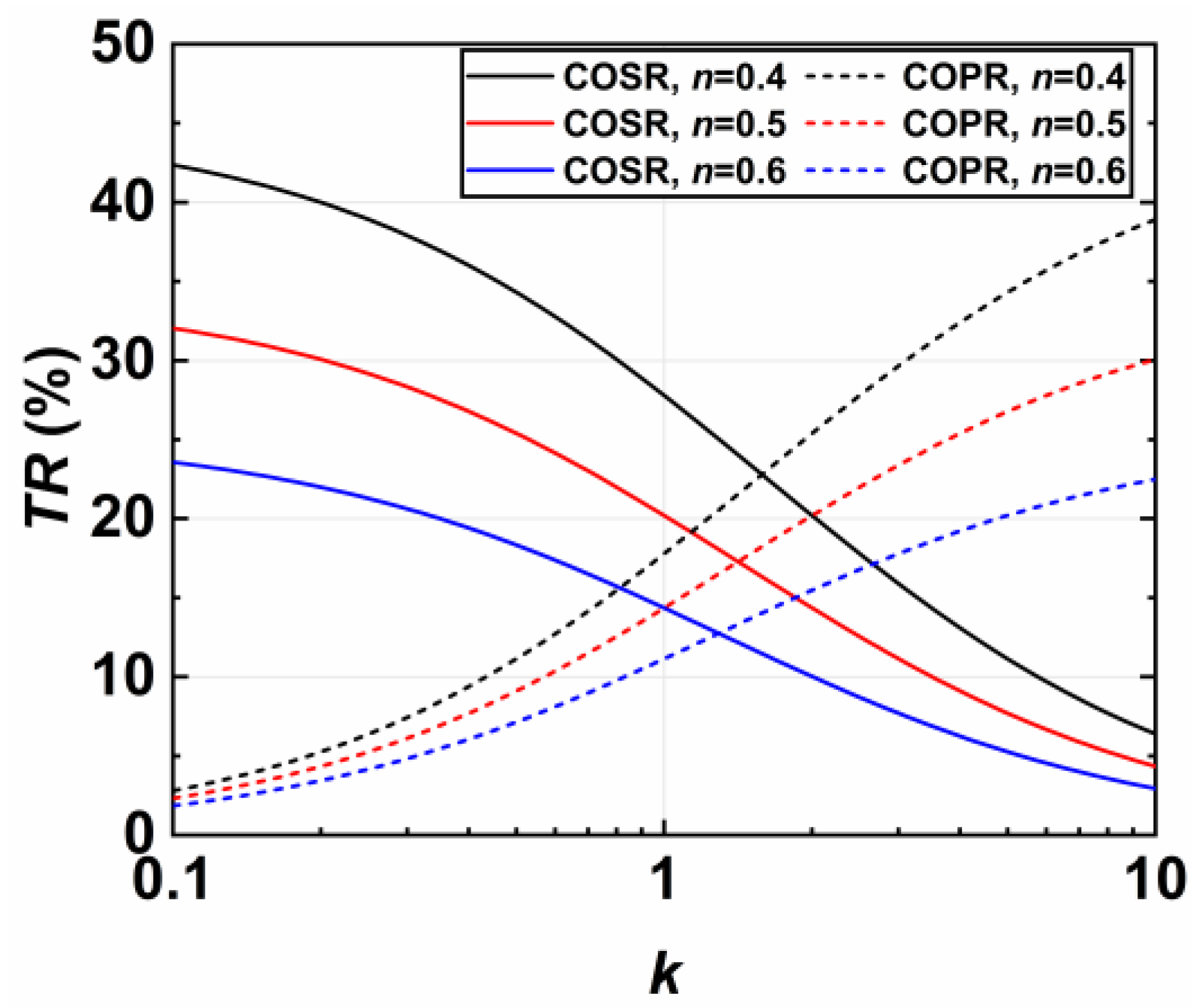
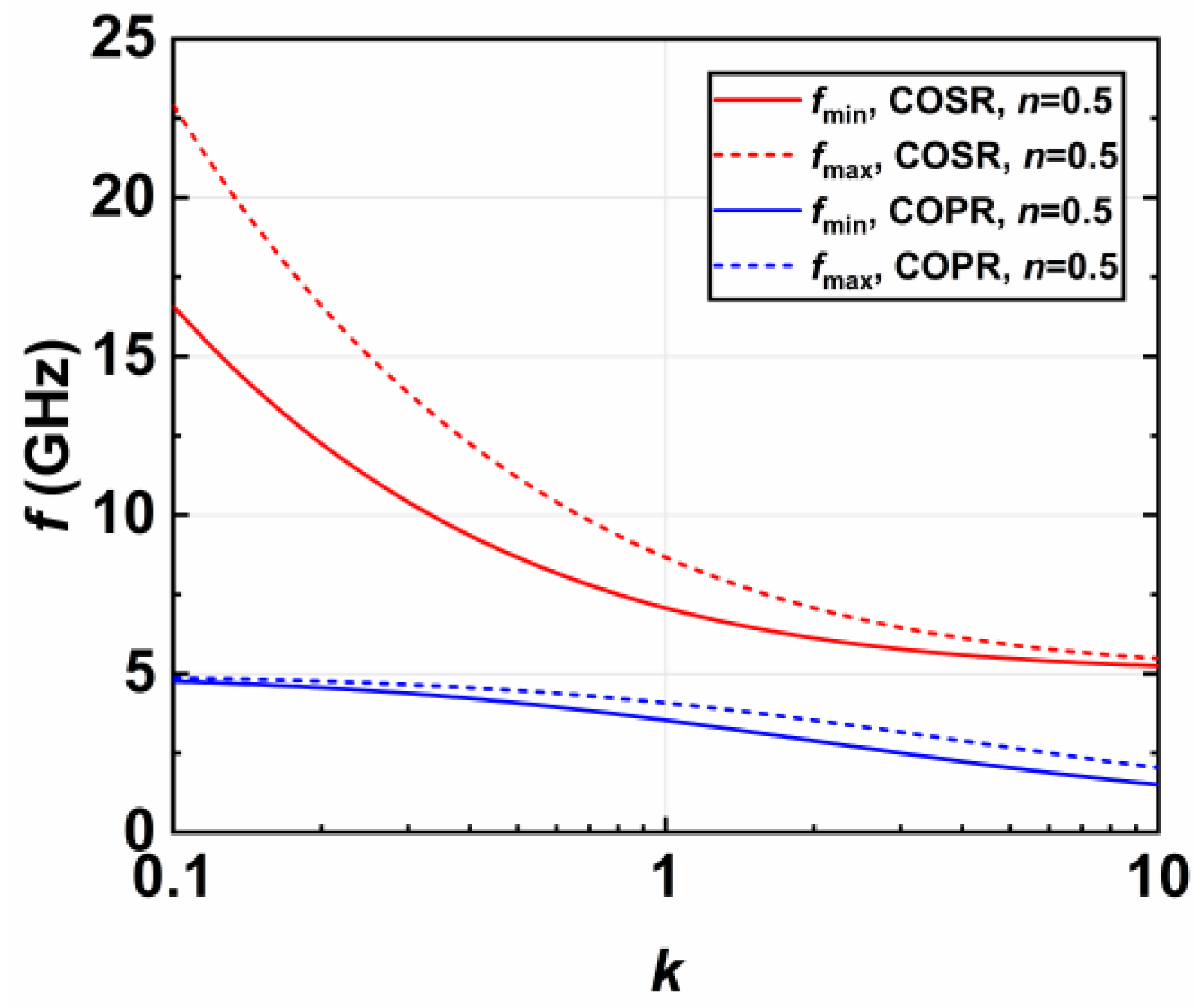
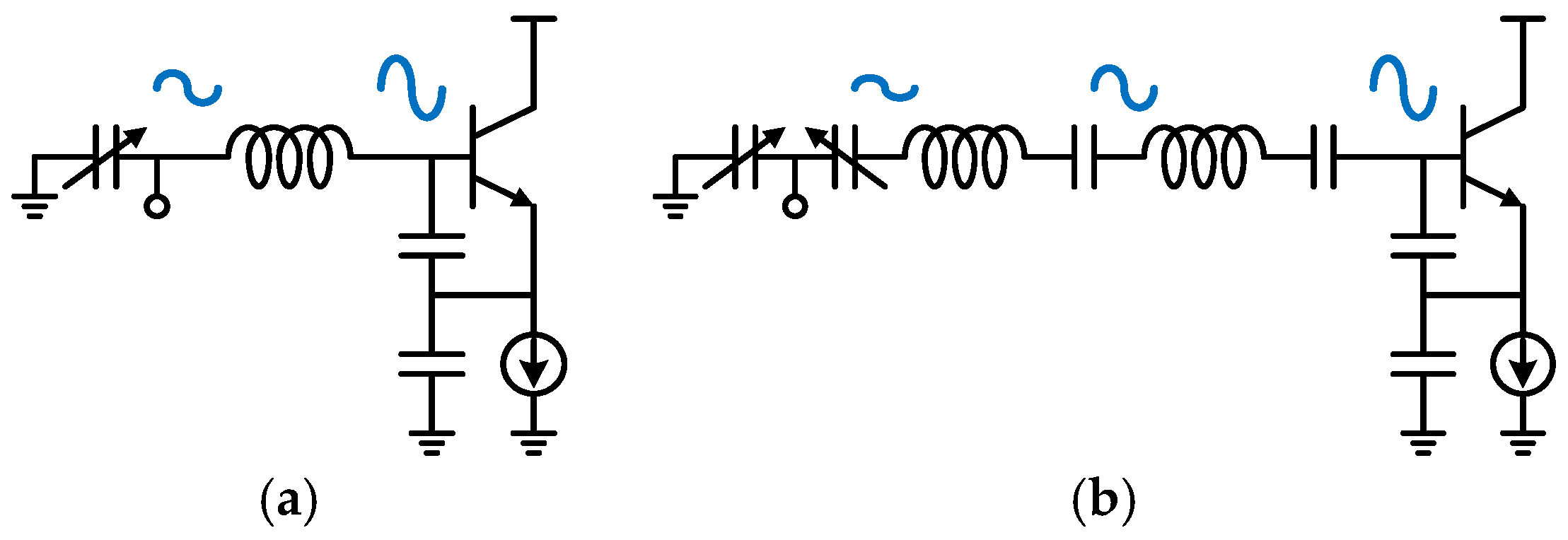
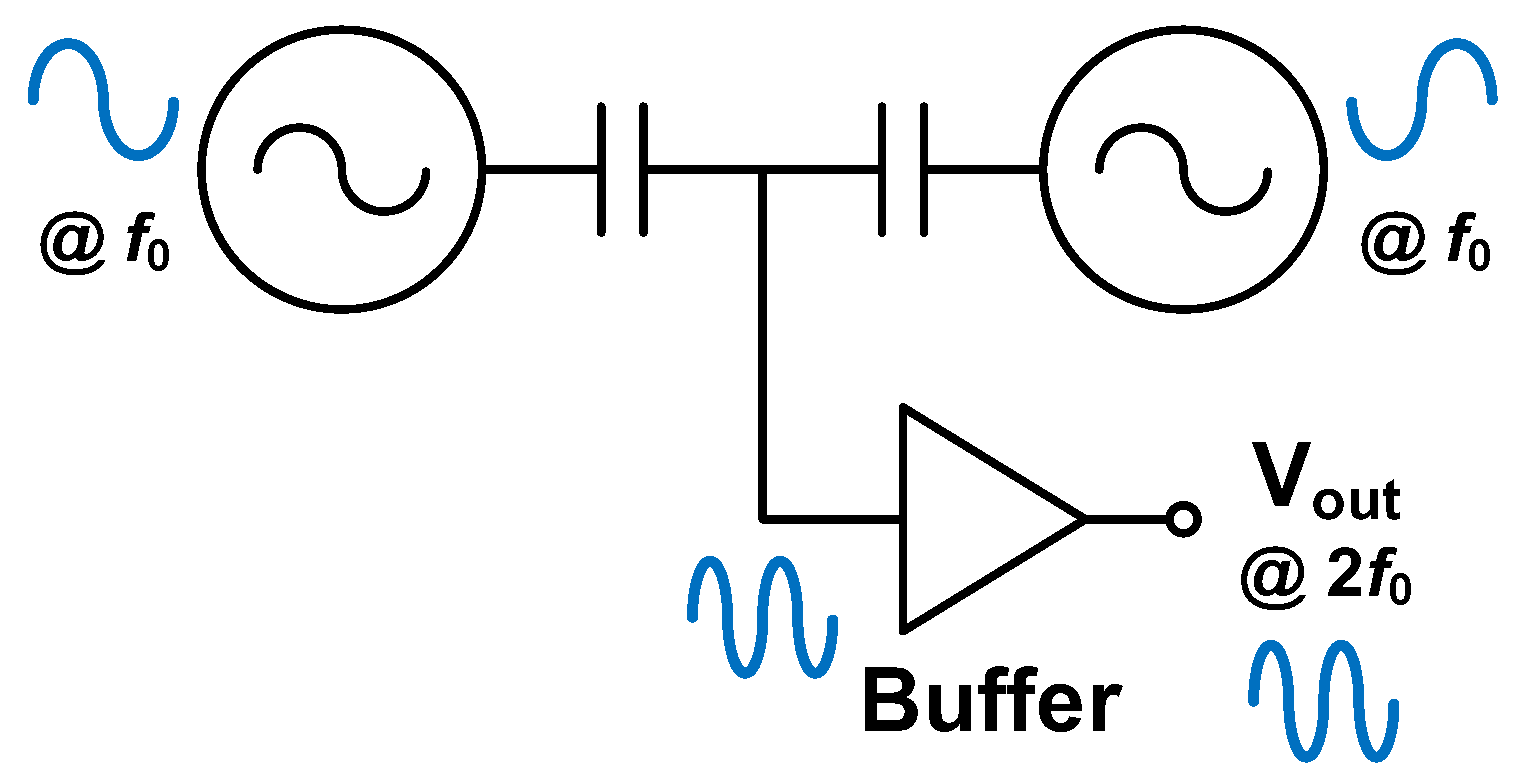



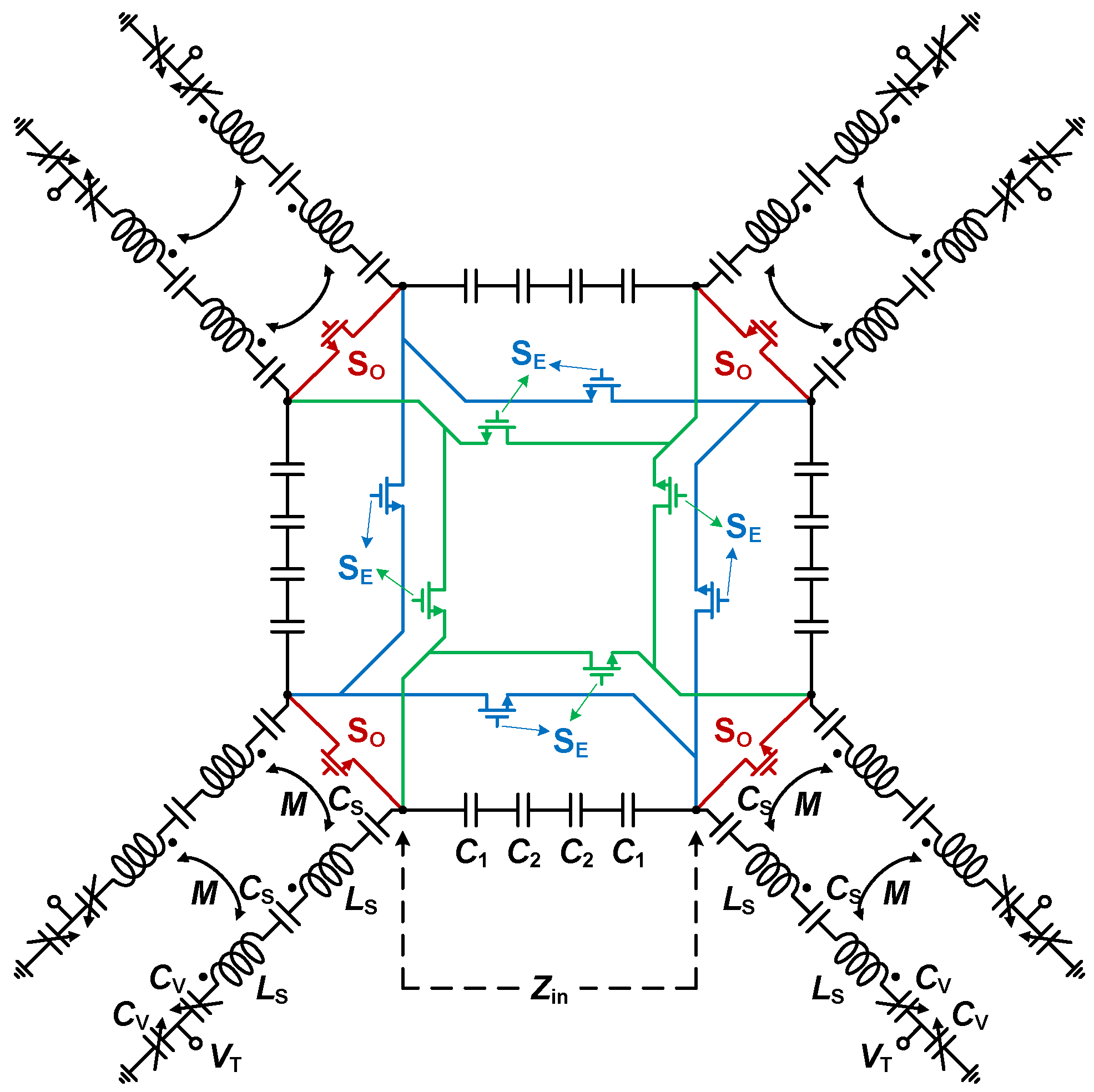

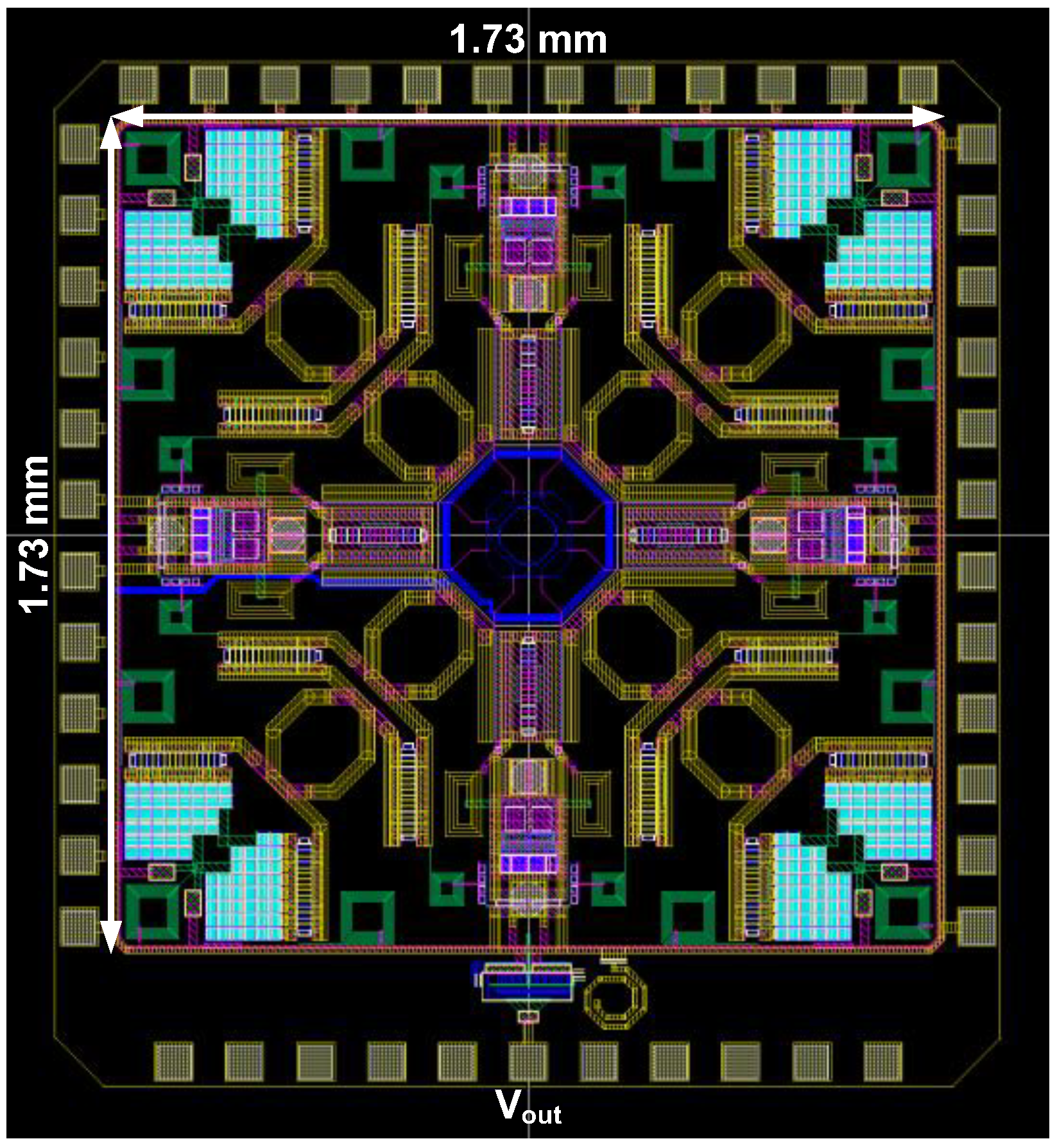



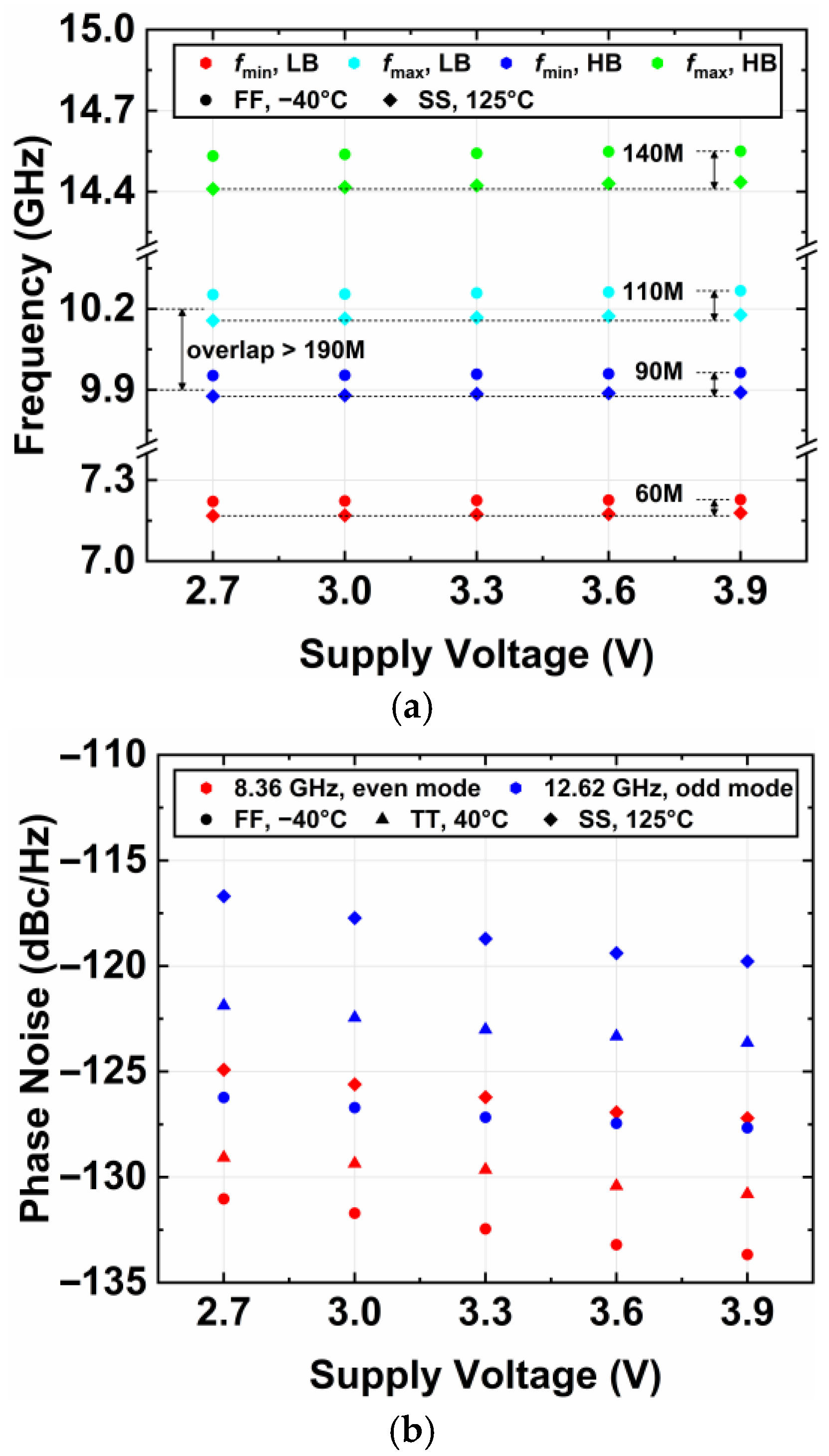
| This work & | ISSCC’24 * [1] | ISSCC’24 * [6] | CICC’24 * [10] | RFIC’24 * [14] | JSSC’22 * [15] | JSSC’24 * [17] | IMS’17 * [29] | |
| Technology | 180 nm SiGe | 40 nm CMOS | 65 nm CMOS | 65 nm CMOS | 65 nm CMOS | 55 nm SiGe | 65 nm CMOS | GaAs HBT |
| Topology | Quad-core Dual-mode Colpitts | Single-core Dual-mode | Quad-core Quad-mode | Dual-mode Class-F | Octa-core Series Resonance | Series Resonance | Series Resonance | Push-push Colpitts |
| Frequency (GHz) | 7.2–14.5 | 8.9–21.9 | 13.7–41.5 | 6.8–11.6 | 11.0–12.2 | 10.0–10.9 | 10.3–11.1 | 10.0–12.3 |
| Tuning Range (%) | 67.3 | 84.4 | 101 | 52.2 | 10.3 | 9.0 | 7.5 | 20.5 |
| Supply Voltage (V) | 3.3 | 0.45 | 0.4/0.55 | 1/1.2 | 1 | 1.2 | 1.2 | 5 |
| Power (mW) | 660–726 | 5.6–14.8 | 2.0–8.8 | 8.0–15.6 | 300 | 600 | 228–330 | 725 |
| Phase Noise (dBc/Hz) @ 1 MHz | −131.4 to −121.8 | −117.3 to −110.5 | −111.2 to –97.7 # | −125.6 to −120.7 | −136.5 to −133.9 | −138.0 to −135.5 | −132.1 to −125.5 | −130 to −122 |
| FoM (dBc/Hz) @ 1 MHz | 183.0–176.8 | 189.8–184.6 | 192.0–182.4 | 193.5–189.0 | 185.3–187.1 | 190–188 | 187.4–182.8 | 183.2–173.4 |
| FoMT (dBc/Hz) @ 1 MHz | 199.5–193.3 | 208.3–203.1 | 212.1–202.5 | 207.9–203.4 | 185.6–187.4 | 189.1–187.1 | 184.9–180.3 | 189.4–179.6 |
| Core Area (mm2) | 3.0 | 0.1 | 0.14 | 0.22 | 3.4 | 0.54 | 0.45 | 8.1 |
Disclaimer/Publisher’s Note: The statements, opinions and data contained in all publications are solely those of the individual author(s) and contributor(s) and not of MDPI and/or the editor(s). MDPI and/or the editor(s) disclaim responsibility for any injury to people or property resulting from any ideas, methods, instructions or products referred to in the content. |
© 2025 by the authors. Licensee MDPI, Basel, Switzerland. This article is an open access article distributed under the terms and conditions of the Creative Commons Attribution (CC BY) license (https://creativecommons.org/licenses/by/4.0/).
Share and Cite
Qi, S.; Xu, S.; Deng, R.; Wu, G.; Zhan, L. A Quad-Core Dual-Mode Colpitts Voltage-Controlled Oscillator with Octave Tuning Range and Low Phase Noise. Electronics 2025, 14, 957. https://doi.org/10.3390/electronics14050957
Qi S, Xu S, Deng R, Wu G, Zhan L. A Quad-Core Dual-Mode Colpitts Voltage-Controlled Oscillator with Octave Tuning Range and Low Phase Noise. Electronics. 2025; 14(5):957. https://doi.org/10.3390/electronics14050957
Chicago/Turabian StyleQi, Shihao, Shang Xu, Ruxin Deng, Guoan Wu, and Lamin Zhan. 2025. "A Quad-Core Dual-Mode Colpitts Voltage-Controlled Oscillator with Octave Tuning Range and Low Phase Noise" Electronics 14, no. 5: 957. https://doi.org/10.3390/electronics14050957
APA StyleQi, S., Xu, S., Deng, R., Wu, G., & Zhan, L. (2025). A Quad-Core Dual-Mode Colpitts Voltage-Controlled Oscillator with Octave Tuning Range and Low Phase Noise. Electronics, 14(5), 957. https://doi.org/10.3390/electronics14050957




